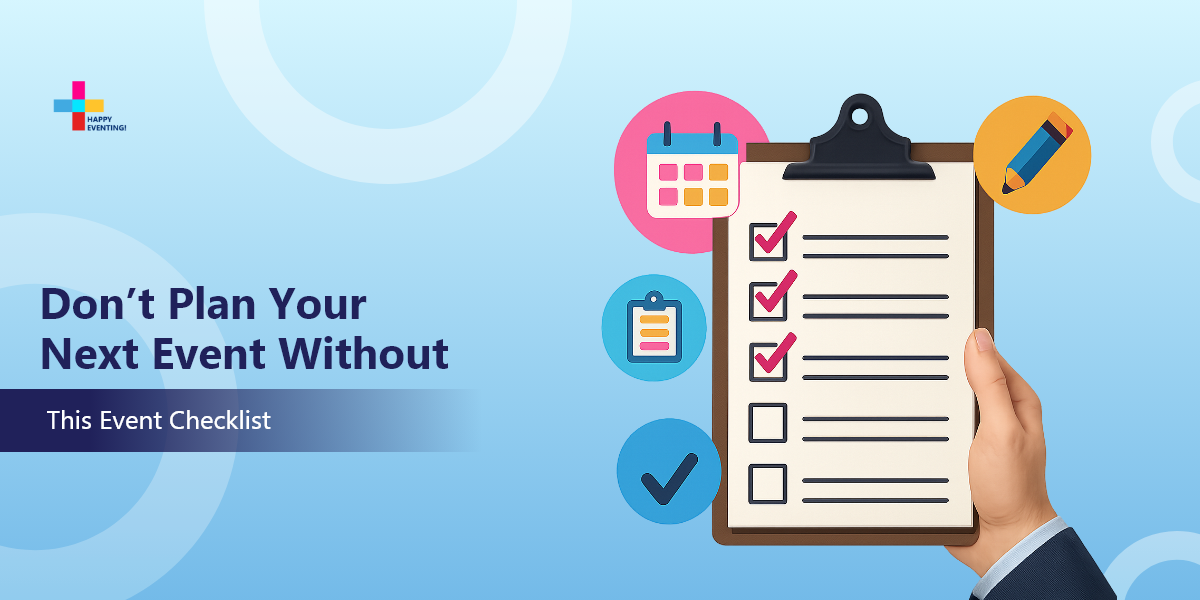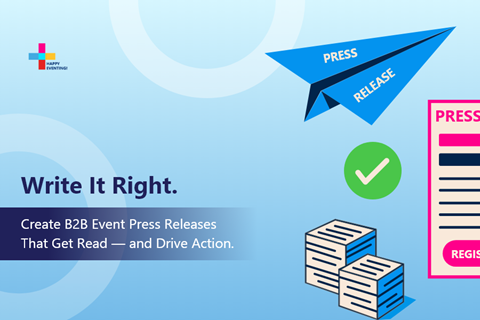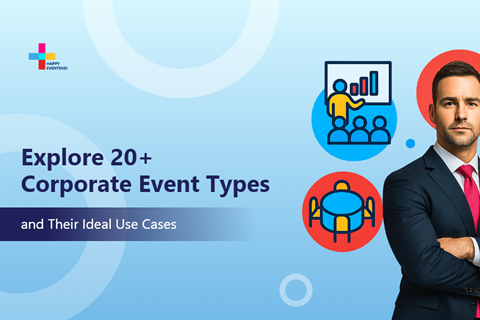

- {{UserName()}}
Request a Demo




You don't get second chances with live experiences. One missed cue, one failed handoff, and months of work can go sideways. Events are no longer just supporting functions or checkboxes—they are central to brand trust, customer conversion, and retention strategy.
A basic to-do list won't cut it. Event teams need a complete, clear, and actionable system. The kind of system this comprehensive checklist provides, one that consistently delivers results under pressure, across formats, with full cross-functional alignment.
This blog is for event organizers who approach their craft with an obsession for perfection. You'll walk away with a proven framework that brings structure, focus, and measurable outcomes to every step of your event planning process.
Event planning is the process of organizing an experience that serves a specific purpose, whether to educate, celebrate, promote, or connect. It's not just about booking a venue or ordering lunch. It involves coordinating dozens (sometimes hundreds) of moving parts such as timelines, teams, tools, vendors, sponsors, speakers, content, technology, and more.
The event planner's job is to bring all of that together, so the experience feels seamless to the attendee and successful to the business.
A strong event plan helps answer questions like:
Modern event planning also means working across departments. It connects marketing goals with sales follow-ups, ties content to customer education, and builds real-time engagement strategies using data and tech.
Whether you're planning an in-person conference, a virtual roundtable, or a hybrid user summit, the goal stays the same—create an experience that delivers value for everyone involved.
Once you understand what goes into planning an event, the next step is making sure nothing slips through the cracks—and that's where a comprehensive checklist becomes essential.
A task list helps you remember. But a strategic checklist helps you execute. It's a structured guide that walks you through every stage of the event lifecycle, before, during, and after. It helps you stay organized, align teams, and make sure every piece supports the bigger business goal.
Here's what a complete checklist should include:
Objectives and KPIs: Start with your "why". Set outcomes upfront: leads, renewals, launches. This is one of the most important early steps to plan an event effectively.
Audience segmentation: Know who you're planning for. Plan content and logistics by role, level, and preferences.
Venue and vendor logistics: Track all location-related details, timelines, access, AV needs, and signage zones through the pre-event checklist.
Tech stack readiness: Make sure your event tools talk to each other—registration, Customer Relationship Management (CRM), email, virtual platforms, and engagement tools. Confirm integrations and test everything well in advance. Always have a backup plan.
Sponsor alignment: For sponsored events, clarify deliverables early. Confirm placements, sponsorship tiers and post-event reporting expectations too.
Real-time engagement: Engagement doesn't just happen—it needs to be designed. Enable polls, feedback tools, and attendance analytics.
Risk and compliance: Cover your bases. Insurance, Americans with Disabilities Act (ADA) access, emergency protocols—these belong on every comprehensive checklist, especially for in-person formats.
Post-event continuity: The event doesn't end when people leave. After the event, launch surveys, analyze results, share recaps, and reuse top-performing content. This forms the backbone of your post-event checklist.
Checklists create consistency. They reduce risk and help everyone focus on execution.
Planning starts long before the doors open. The comprehensive checklist begins here—with the strategy, tools, and alignment needed to set your event up for success.
The pre-event checklist is the foundation of your entire event. It covers the strategic planning phase—from setting goals to aligning sponsors and selecting tech. Getting this right ensures everything that follows runs smoother and supports your larger business outcomes. A solid framework always starts here.
Your event needs a clear purpose. When you define objectives and KPIs, you give your team, vendors, and partners a shared direction that informs every choice.
☐ Define the primary goal of your event (e.g., launch, lead generation, education, retention)
☐ Map that goal to specific post-event outcomes (e.g., leads, renewals, app downloads)
☐ Set fixed KPIs (attendance percentage, sponsor ROI, Net Promoter Score (NPS), lead numbers)
☐ Align stakeholders so everyone is working toward the same success metrics
☐ Break down goals by team or department so each group knows their target
☐ Document goals to guide content planning, vendor selection, and budget decisions
A successful event connects with the right people in the right way. Define and understand your audience so that every element of your event resonates.
☐ Identify core audience types (e.g., industry, job role, seniority)
☐ Segment your audience to tailor content, networking, and experience
☐ Send early interest surveys to capture demand for specific topics
☐ Add "I'm interested" calls to action on your emails and web pages to gather early signals
☐ Use survey insights to shape your session tracks
☐ Plan for VIP areas, breakout rooms, and general sessions that fit your audience
☐ Confirm language support and accessibility requirements
☐ Collect dietary restrictions so catering meets all attendee needs
Your venue sets the stage for everything that follows. Select and lock down details that ensure the space supports your goals, technology, and attendee experience.
☐ Shortlist venues by capacity, location, and how well they fit your theme
☐ Schedule site visits or arrange detailed virtual tours
☐ Review floor plans for traffic flow and sponsor visibility
☐ Confirm AV, Wi-Fi, and power capabilities
☐ Check delivery access, parking, and loading zones
☐ Build setup and teardown time into your contracts
☐ Finalize insurance, cancellation terms, and reschedule policies
Your budget is more than numbers. It is the tool that helps you balance vision and practicality while planning for the unexpected. A well-managed budget is a pillar of every efficient planning framework.
☐ List all line items including small expenses (e.g., signage, snacks)
☐ Add a buffer of 10-15% for contingencies
☐ Compare your budget against past events or benchmarks for approval
☐ Finalize budget with stakeholders and sponsors
The right event technology keeps your event running smoothly behind the scenes. Select tools early and ensure they work together to support your team and attendees.
☐ List all tools you need (e.g., registration platform, app, CRM, streaming service)
☐ Research platforms suited for your format (e.g., in-person, hybrid, virtual)
☐ Set up integrations with email, CRM, and marketing systems
☐ Plan for backup Wi-Fi, power, and onsite IT support
☐ Schedule demos and team test runs to confirm usability
Your event's visual and verbal identity should be clear, consistent, and memorable. Get creative direction in place so every touchpoint feels intentional.
☐ Finalize logo, tagline, colors, and fonts
☐ Create a mood board for presentations, signage, and promotional items
☐ Lock your brand tone (e.g., formal, conversational)
☐ Design templates for slides, badges, signs, and emails and customized event app
☐ Plan branded swag that aligns with your event theme
☐ Confirm print specifications and timelines with vendors
Sponsors and internal teams contribute to your event's success. Align everyone early so expectations and responsibilities are clear.
☐ Identify key internal teams and loop them into planning
☐ Build sponsor packages with tiered benefits
☐ Begin outreach to potential sponsors and partners
☐ Offer early VIP exposure to key sponsors
☐ Schedule coordination meetings with sales, marketing, and operations
The during-event checklist helps you manage everything in real time while the event is live. From check-in to engagement tracking, it ensures your team stays in sync, attendees feel supported, and issues get handled fast. This stage is where planning meets execution and where the right framework can make or break your impact.
Your first impression counts. Make check-in fast and frictionless to set the tone for a positive experience.
☐ Position staff at all entry points to manage crowds
☐ Set up onsite badge scanning for seamless access tracking and entry
☐ Adjust check-in stations based on actual traffic patterns
☐ Run a dedicated VIP check-in lane
☐ Confirm stable Wi-Fi at all entry points
☐ Monitor attendance in real time
Your team keeps the event on track. Maintain clear, fast communication so you can respond to anything that comes up.
☐ Schedule regular check-ins with team leads throughout the day
☐ Activate radios, Slack, or other communication tools
☐ Prepare contingency messages for urgent updates
☐ Review health and safety alert protocol
☐ Share emergency contacts with all team leads
Engagement drives value for attendees and sponsors. Track it in real time so you can adjust and improve during the event.
☐ Use live polling and feedback tools
☐ Track attendance and engagement by session
☐ Monitor heat maps and social interaction to spot trends
☐ Brief speakers on audience engagement tools
☐ Adjust agenda or room assignments as needed to avoid overcrowding or low turnout
Your event's digital footprint builds reach and value. Promote and manage it actively as the event unfolds.
☐ Promote and monitor your branded hashtag
☐ Engage with attendee posts to boost reach
☐ Post photos, quotes, and videos in real time
☐ Include sponsor tags and mentions in posts
☐ Run live feeds or social walls onsite
Preparedness protects your event's success. Make sure you are ready for health, safety, and technical challenges.
☐ Post clear emergency signage at key points
☐ Review safety procedures with staff at the start of the day
☐ Keep first aid stations visible and stocked
☐ Monitor crowd flow to prevent clustering
☐ Staff restricted areas to control access
☐ Stage spare AV equipment and backup files
☐ Activate weather plan and test mobile hotspots
The post-event checklist ensures your work doesn't stop when the event ends. It's your follow-through plan—for collecting insights, reporting outcomes, and repurposing content. This final stage helps you prove ROI, strengthen relationships, and improve future events. Every effective planning framework ends with a strong post-event strategy.
Prompt follow-up reinforces value and keeps relationships warm.
☐ Send personalized thank-you emails within 24 hours
☐ Tailor follow-ups using engagement data
☐ Include clear calls to action (e.g., survey links, content downloads, future event registration)
☐ Share sponsor ROI reports
☐ Deliver exclusive post-event content
Your event is a learning opportunity. Capture what worked and what can be improved while the details are fresh.
☐ Hold an internal and vendor debrief within 48 hours
☐ Document wins and areas for improvement
☐ Collect feedback from vendors on delivery and logistics
☐ Archive key takeaways for future planning
Quantify your event's success and use the data to support future decisions. A strong planning framework doesn't just focus on logistics—it closes the loop with insight.
☐ Measure outcomes against your original goals
☐ Analyze core KPIs (e.g., attendance, leads, engagement)
☐ Distribute sponsor satisfaction surveys
☐ Calculate ROI based on spend versus impact
Keep the momentum going by reusing valuable content.
☐ Clip top moments for social sharing
☐ Repackage decks and user-generated content
☐ Distribute post-event materials via email
☐ Write blog posts to extend thought leadership
Feedback shapes your next event. Collect it thoughtfully and apply what you learn.
☐ Launch post-event survey within 3 days
☐ Ask targeted questions about content and logistics
☐ Track NPS and sentiment
☐ Review feedback for actionable trends
☐ Integrate insights into future planning
Not every event needs every extra—but the best planners prepare for more than the basics. These add-on checklists help you cover accessibility, safety, sustainability, and virtual readiness. Use them to fill the gaps and future-proof your strategy. A complete planning framework should always be flexible enough to adapt.
A virtual or hybrid event needs just as much care as an in-person experience. Ensure your platform, speakers, and tools are ready for success.
☐ Confirm platform capabilities (e.g., streaming, chat, breakout rooms)
☐ Complete tech checks with all speakers (audio, lighting, background)
☐ Assign moderators for chat, transitions, and audience Q&A
☐ Conduct rehearsals with speakers and moderators
☐ Prepare virtual engagement tactics (polls, icebreakers, chat prompts)
☐ Finalize breakout session flow
☐ Configure recordings, captions, and accessibility settings
Sponsors expect clear value. This checklist ensures you deliver on commitments and build long-term relationships.
☐ Review sponsor contract deliverables (booth, speaking slots, visibility)
☐ Confirm logo and branding placements
☐ Activate pre-event sponsor exposure (social, email, promotions)
☐ Prepare sponsor zones onsite or virtually
☐ Build post-event sponsor reports (leads, traffic, engagement)
☐ Collect sponsor feedback
☐ Outline long-term sponsor engagement strategies
Inclusion should never be an afterthought. These checks ensure all guests can participate fully.
☐ Verify ADA compliance at all venue points
☐ Arrange sign language interpreters or real-time captioning
☐ Plan sensory-friendly areas
☐ Confirm language support for translations and materials
☐ Track dietary restrictions and allergen labeling
☐ Review common areas for accessible restrooms and elevators
Even the best plans need a backup. Use this list to stay prepared.
☐ Implement cybersecurity protocols for digital and hybrid events
☐ Activate medical and health emergency plans
☐ Build weather contingency plans
☐ Create a PR crisis communication plan
☐ Confirm backup power solutions
☐ Secure vendor fallbacks for critical services
☐ Test emergency communication systems
Make your event greener with thoughtful choices that reduce environmental impact.
☐ Prioritize digital-first materials to reduce paper waste
☐ Choose eco-friendly catering partners (local, sustainable options)
☐ Source recyclable or biodegradable materials
☐ Request energy-efficient setups from your venue
☐ Curate sustainable swag (reusable or compostable items)
☐ Promote green transportation options
☐ Select carbon offset programs
Structure helps. Especially under pressure.
Events are high-visibility investments. A clear, detailed planning framework gives your team the direction they need to execute with confidence—and prove ROI when it's over. Every item checked off is one less fire to fight on show day.
Whether you're building executive alignment, launching a product, or deepening partner relationships, this framework keeps things on track from planning to performance.
Want a full system?
Download the Ultimate Event Checklist to start customizing your own version.
Manage the full stack: registration, engagement, vendors, and ROI seamlessly with Eventcombo.
Book a demo and see how it all connects.

You don't get second chances with live experiences. One missed cue, one failed handoff, and months of work can go sideways. Events are no longer just supporting functions or checkboxes—they are central to brand trust,...

Most B2B event press releases read like formal checklists, just a list of details no one remembers. But it’s crucial not to treat it as just an announcement. It’s your first shot at positioning your event in the market.

Corporate events are how companies bring people together to drive business forward, whether that’s customers, partners, prospects, or their own teams. Organizations are using different types of corporate events to...